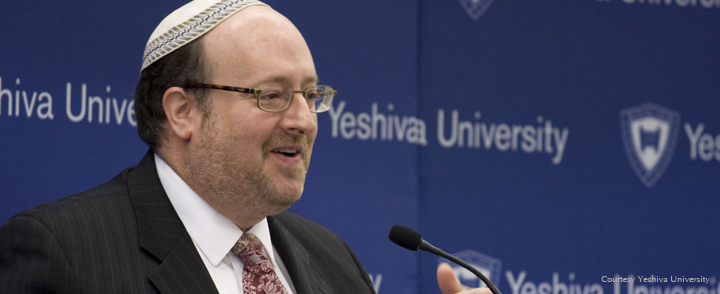By Emily K. Alhadeff, Associate Editor, The Jewish Sound
Rabbi Kenneth Brander took a part-time, two-year job as rabbi of a 60-family congregation in Boca Raton, Fla. with the idea that he’d have lots of time to write about his experiences living with and assisting Rabbi Joseph Soloveitchik during the last years of his life.
“‘Yeshiva University will publish what you write about Rabbi Soloveitchik,’” former YU president Norman Lamm told him of one of the 20th century’s leading rabbinic figures. “‘You should just sit and write about his customs, what you saw, what you engaged with. And we’ll publish it.’”
Instead, he grew the small Modern Orthodox congregation into a metropolis of Jewish life, with 600 families, an eruv, a Kollel, a yeshiva high school, and kosher kitchens across the region.
“Two years became 14 years,” Brander said. “I didn’t really write much about Rav Soloveitchik.”
Entrenched in the community in Florida, Brander said he never considered moving back to New York until current YU president Richard Joel tapped him to come back to the university to export his successful models of community building.
Brander, a 1986 YU graduate, is now its vice president for university and community life and the Dan Mintzer Dean of Yeshiva University Center for the Jewish Future. He was in Seattle over the Shabbat of June 20 as a guest of Bikur Cholim Machzikay Hadath, Minyan Ohr Chadash, and Sephardic Bikur Holim, where he gave three talks over Shabbat.
The goals of YU’s new Center for the Jewish Future are “infusing the student body with a spirit of leadership and a sense of responsibility to the Jewish people and society in general”; “building, cultivating, and supporting communities, and their lay and rabbinic leaders”; and “creating a global movement that promotes the values of Yeshiva University.”
“Goal number one is to inspire students to make a difference,” Brander said.
Comparable to a well-known phenomenon in the non-Orthodox Jewish world of short-term, international humanitarian work, like alternative spring break, YU now sends students to various places, like Nicaragua, Rwanda, and Israel, to work with Jewish and non-Jewish communities on an issue of importance.
For example, every year 50 students travel to Kiryat Malachi, Israel — incidentally, a sister city of Seattle — to work with at-risk high school students on skills and self-esteem. Brander says their work has been so critical — to the point of preventing suicides — that the Kiryat Malachi school system changed its winter break to align with the YU students’ trip.
“Our goal is not to make them Orthodox,” said Brander of the Kiryat Malachi youth. “It’s to say, ‘You can be cool and value something more than your own self-indulgence.’”
The students are also working locally on a long list of projects, like running science labs and practicing music therapy. Brander points out that the Hebrew word “natan,” to give, is a palindrome. In other words, it goes both ways. He speaks of a sense of idealism among the students.
“There’s a whole culture now of giving to the larger community, and how it transforms you,” he said. “Our students realize we live in a world that’s all about ‘I.’ We have to change that paradigm.”
Another area the center Brander runs addresses a highly scrutinized, yet overlooked, group of people: Rabbis’ wives, lay leaders, and even rabbis themselves. The center provides seminars, education, resource guides, and job placement for rabbis, and spiritual retreats and ongoing support for rabbis’ wives and lay leaders.
“Most rabbis’ wives have advanced degrees,” he said. “They’re bringing up a family, and they have this third job they never signed up for” — that is, being the rabbi’s wife.
For instance, Brander said, “What happens when the rabbi’s wife wants to see women’s issues differently than the man she shares the bedroom with? How does she communicate to her husband that he needs to see these issues differently?”
Brander notes that rabbis are trained in volumes of Jewish legal literature, but miss “the volume of common sense.” He brings in professors of psychology, medical ethics, and other fields to train rabbis in pastoral counseling, and he brings in Broadway actors to simulate crisis situations. Why should a rabbi be somehow better equipped to handle tragedy and crisis?
“Who’s helping the rabbi?” asked Brander. “Who’s making sure the rabbi’s doing Okay?”
Brander’s early life may have prepared him for his job today. As a young student activist for Soviet Jewry, Brander found himself in jail on many occasions.
“Our goal was not about hurting law enforcement,” he said. “It was about speaking truth to power.”
He snuck into Russia to teach Talmud and into Estonia to run a model seder. The phones were tapped, of course, and anyone who attended the seder ended up losing their electricity and phone service for a day.
“At the end of the service the KGB walked in and told us we had an hour to leave,” he said. “They put us on a bus and threw us into East Germany.”
Brander believes strongly in providing “multiple portals for spiritual entry,” and quotes it as the key to his success in Boca Raton. He compares it to the ancient Temple.
“I believe the Beit HaMikdash was a place of music, social action, ecological responsibility, formal education, experiential education, youth education, education,” he said. “We always think of it as a place of sacrifice…. Synagogues are the spiritual progeny of the temple, and they have to follow that mission statement.”
Brander is completing a doctorate now, and he’s writing his dissertation on this subject. Synagogues he has studied are successful when they create multiple portals for entry; as soon as they close them off, they decline.
“People are searching for spirituality, but Judaism is no longer a forced religious experience,” he said. “It’s up to us to create a religious experience that has color, that has nuance, that has spirit.”
